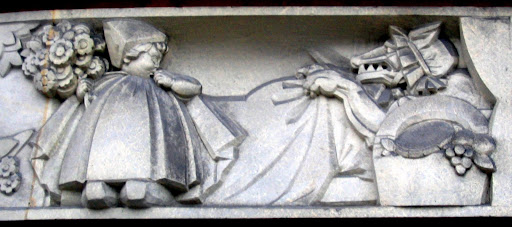
Aboyne Lodge Primary School, St Alban’s
Built by Hertfordshire CC, opened 1950
(Architectural team included David Medd and Mary Crowley)
Tobias and the Angel by Daphne Henrion
Originally located in forecourt, now removed for security reasons to inner courtyard. (photo from current school website). David Medd’s unpublished Personal Account has a 1950 photo (p.48) of the sculpture in its original location.
In a romantic story from the ancient biblical Book of Tobit, Tobias is sent on a mission by his father. A good-for-nothing only interested in dancing, he is offered guidance by a stranger, and taught to pay attention to the world around him, to listen to the songs of the trees, the mountains, the river. After many adventures with a happy ending, the stranger is revealed as the angel Raphael.
It seems an especially apt image for the school’s current ethos. Its website declares that it wants ‘our children to be curious and caring about the world around them’, to achieve ‘in partnership with parents … a positive and enthusiastic attitude to learning … for future success and happiness in the lives of our pupils’.
Daphne Henrion (1917 –2003) attended the Royal Academy Schools in
She remained figurative during the dominance of abstraction and modelled in traditional materials. Her public sculptures have been appreciated for their tender humanity, unpretentiously direct in expression. She described her approach as ‘entirely traditional and not at all intellectual, being a direct expression of my perception of people and situations. I am glad when my work is appreciated by quite ordinary people as well as by my colleagues.’

No comments:
Post a Comment